Becoming a scientist: Following my passion
For immediate release ‐ April 28, 2021
Contact: Micah Beasley, 919.707.9970. Images available upon request
By Dr. Julie Horvath, Head of the Genomics & Microbiology Research Lab and jointly appointed at North Carolina Central University
Lesson 1: Find your passion!
Hold up your right hand with your palm facing toward you. Now touch the middle of your palm. This is where I grew up in Michigan – right in the middle near the capital city of Lansing! I spent a lot of time outside exploring my backyard, hiking with my dog, or playing in the field near my house with my best friend. We explored so many logs and ponds, and found amazing creatures lurking there.
I spent my summers at a cottage in the North Woods of Mercer, Wisconsin – the loon capital of the world. In the backwoods of Wisconsin, I observed (and sometimes befriended) the animals in the forest. This is how I fell in love with nature and animals.
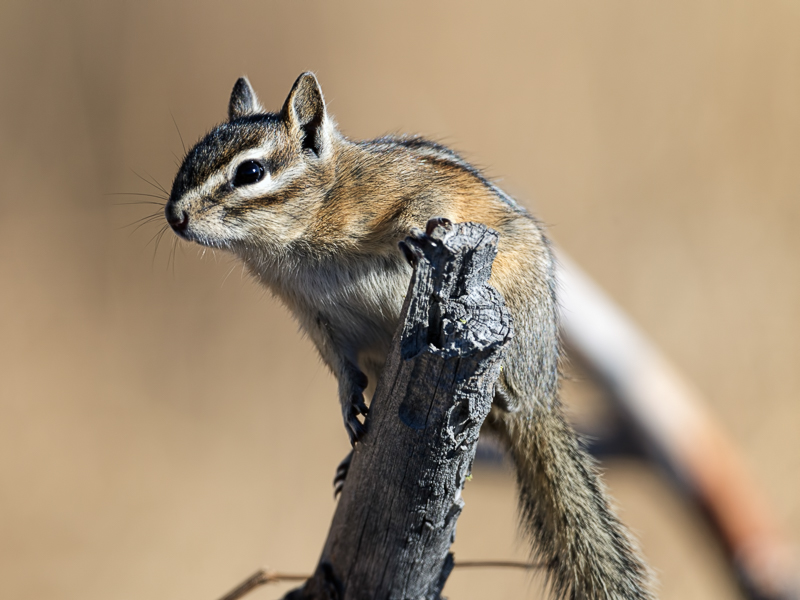
Have you ever wondered why chipmunks are easy to tame, but crows stay their distance from most humans? By watching the animals, I started to wonder why some species (chipmunks, chickadees, and hummingbirds) allowed me to get closer to them than others (crows). I was fascinated by different animal behaviors and realized I also wanted to help them. I tried to save injured caterpillars, and I nursed injured birds and chipmunks back to health.
Lesson 2: Shadow people with different careers to find out what you do and don’t enjoy!
One obvious career choice would have been as a veterinarian. After I shadowed our local veterinarian, I soon realized that I would have trouble seeing animals in pain, so this shadowing opportunity helped me realize this was not the career choice for me.
Following my animal interests, I attended Michigan State University (MSU) for my bachelor’s degree, and started with a major in zoology with a concentration in animal behavior. I thought this would be a great fit since I had enjoyed watching and studying animals at my cottage. I quickly realized I wasn’t excited to learn about behavior from books though – I wanted to get my hands into science. After taking a genetics course in college, I fell in love with genetics. I liked being active in a laboratory and conducting experiments!
Lesson 3: Find someone who supports you!
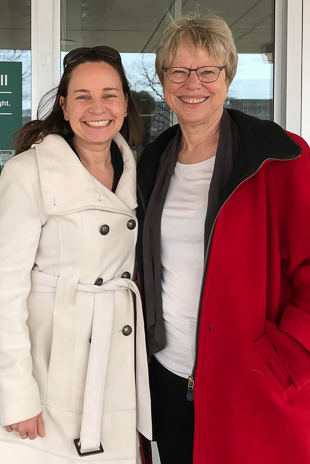
A recent photo of Julie with Dr. Karen Friderici.
I wanted to conduct my own research so I joined the lab of Dr. Karen Friderici at MSU. We studied a genetic disease, Beta-mannosidosis, that affected Nubian goats and Salers cattle. It is a recessive disease, which means that two mutated copies of the MANBA gene are required to develop the disease. Dr. Friderici developed a genetic test to determine which animals had two normal copies of the gene, or one or two mutant copies of the gene. We traveled to farms across the state to collect samples from goats for testing. We reported back to the farmers which animals carried one copy of the mutant gene so they knew not to breed them. This animal interaction combined with genetics solidified my interest in continuing to do research and pursue a PhD. To this day, I still remember the pungent smell of the goats – and I cannot eat goat cheese!
Spending time doing fieldwork made me realize that as much as I loved doing experiments in the lab, I also loved being outside with animals. I took a job at the Potter Park Zoo to explore a zoo career and I worked at the camel ride exhibit in the summers. I spent my lunch hour watching the lemurs and knew I wanted to work with them in the future.
Once graduated from MSU, my path led me to Cleveland, Ohio, where I joined the PhD program at Case Western Reserve University for a graduate degree in Human Genetics. I conducted research in Dr. Evan Eichler’s lab where we worked on the Human Genome Sequencing Project. We compared specific regions of the human genome to regions in other primates to understand how genomes change over evolutionary time. The work was fascinating and I loved looking at the DNA sequence to try to understand how certain changes make humans unique.
While finishing graduate school, I read an article from scientists who studied the DNA from honeybees and found certain gene regions that impacted how certain hive members behaved. This re-ignited my passion for understanding how some gene variants might explain the behavioral differences I saw in different animal species when I was young.
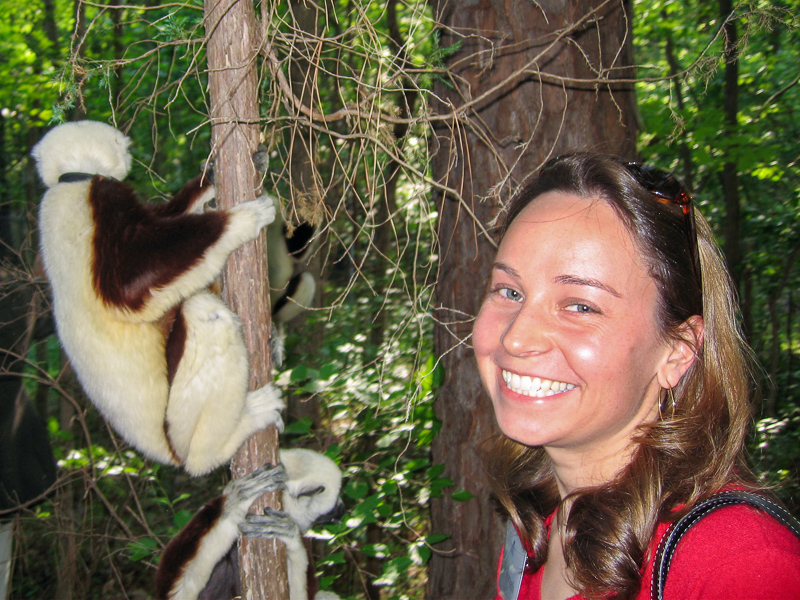 Julie with Coquerel’s Sifakas at the Duke Lemur Center.
Julie with Coquerel’s Sifakas at the Duke Lemur Center.
I graduated with my PhD and followed my passion to Duke University where I did additional training as a postdoc to connect my genetic research training with behavioral scientists studying lemurs at the Duke Lemur Center. I reached out to different researchers studying primate behavior and neuroscience, and several of us began a new initiative called the Primate Genomics Initiative to connect scientists from different disciplines with genetic research. In order to help other researchers realize the importance of lemurs, I worked with international researchers and collected lemur DNA samples to determine the evolutionary relationships among all of the lemurs at the Duke Lemur Center, and then compare them to hundreds of other primates.
Lesson 4: Stay true to your passions and be patient when finding your path
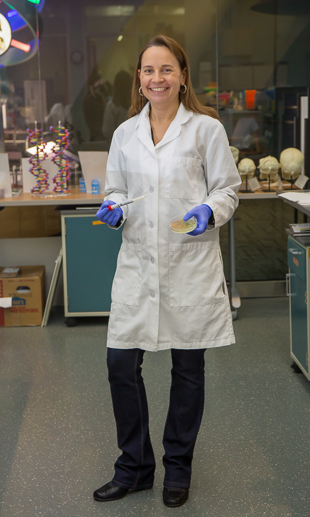
Julie in the Genomics and Microbiology Research Lab.
Photo: Matt Zeher.
When I heard about the opening of the Nature Research Center, I was excited about the potential to work in a Museum setting and to share my passion with students and the general public. I got the job! I now hold a joint appointment as a research associate professor at North Carolina Central University in Durham, NC, and as the head of the Genomics and Microbiology Research Laboratory in the NC Museum of Natural Sciences. I conduct lemur and other non-human primate research to understand how genetic changes across primates play a role in what makes each species and individual unique. As a way to engage students and Museum visitors, I also study the microorganisms (tiny microscopic creatures such as bacteria, Archaea, and fungi) living on human and non-human primate skin to understand how our daily habits impact them, and how they impact our behaviors and health.
On a daily basis I involve undergraduate and graduate students as well as K-12 students and the public in my research. I encourage undergraduate and graduate students at NCCU to share their research with the public and I work with education, exhibits, and veterinary staff at the Museum to have a myriad of opportunities that constantly engage my interest. Now I share with others my passion for science, lemurs, other primates, and the microorganisms that share our world!
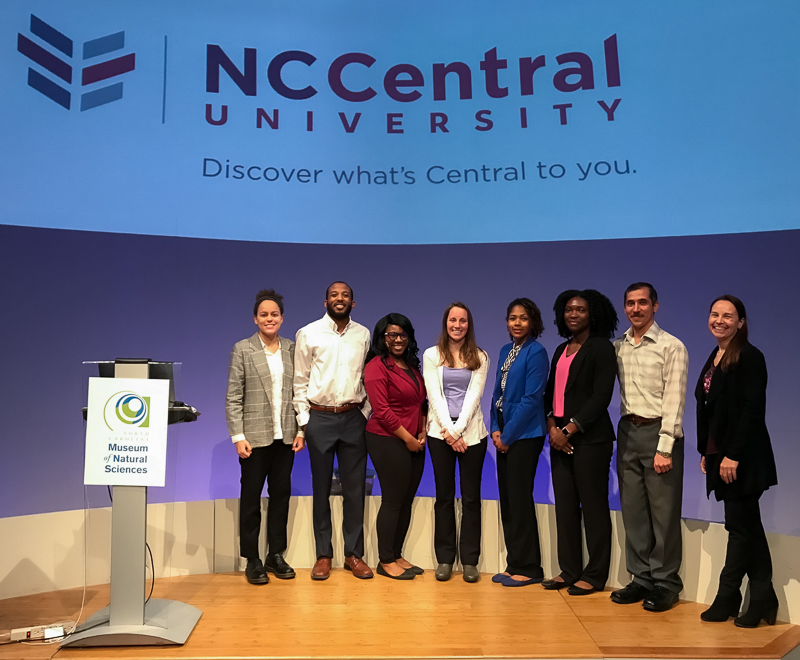 Julie hosting NCCU graduate students who presented their research at the Museum.
Julie hosting NCCU graduate students who presented their research at the Museum.
For more information about our upcoming activities, conservation news and ground-breaking research, follow @NaturalSciences on Instagram, Twitter and Facebook. Join the conversation with #visitNCMNS.

